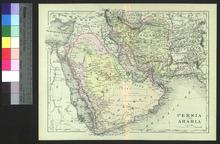1 - 10 of 10 records
Asie Ancienne (1812)
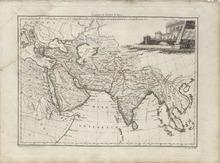
Description: Single page historical copper engraved ap of the ancient Asian Continent. The map also covers Turkey, Israel, Lebanon, Italy, Croatia, Albania, Russia, Ukraine, Crimean Peninsula, Greece, Cyprus, Arabian Peninsula, Egypt, and the Eastern Coast of African Continent. The map shows several geographic details on cities, towns, rivers, mountains, and islands. The map features a vignette of a monument incorporating the title. Cities that appear on the map include: Malao (Berbera), Somalia, Adulis, Eritrea, Berenice Troglodytica, Syene (Aswan), Nechesia, Thebae (Thebes), Myos Hormos, Memphis, and Heroapolis, Egypt, Hyerosolyma (Jerusalem), Israel, Damascus, Syria, Tyrus (Tyre), Lebanon, Amathus, Cyprus, Aelana (Aqaba), Jordan, Modiana, Rhaunathi, Iambia, Arga, Macoraba, Thebae, Gerra (Gerrha), and Uumala, Saudi Arabia, Musa, Cane (Al Mukalla), and Sabbata, Yemen, Ausara, Oman, Babylon, Iraq, Susa, Ecbatana, Rages (Rey), Aspadana (Isfahan), Persepolis, Taoce, Carmana (Kerman), Paragarda, Gagana, Iran, Ozene, Barygaza (Bharuch), Heptanesium (Bombay or Mumbai), Harmagera, Nitria, Tyndis (Kadalundi), Muziris, Barace (Purakkad), Plitana, Tagara, Modura, Calinga, Gangesegia, and Palibothra (Pataliputra), India, Thinae, Thailand, Lahoru (Lahore), Aornus (Aornos), and Taxila, Pakistan, Maracanda (Samarkand), Uzbekistan, Bactra (Balkh), and Prophthasia (Alexandria Prophthasia), Afghanistan, Phasis (Poti), Georgia, Melitene (Malatya), Antiochia (Antioch), Iconium (Konya), Gangra (Çankırı), Byzantium (Istanbul), Mazaca (Kayseri), Sardes (Sardis), and Uins, Turkey Also the unknown cities of Tadmora, Dirithotis, Pella, Tadmora, Tisa, Malana, Pattalene, Gagasmira, Issedon Scythica, Maliana, Sogdae, Arachotus, Ladissa, Trapesus, and Artucona Source publication: Atlas Complet Du Precis De la Geographie Universelle De M. Malte Brun dressee par M. Lapie Capitaine Ingenieur Geographie Pierre M. Lapie (1779-1850) and his son Alexandre Emile Lapie (1809-1850) were French cartographers and engravers active in the early part of the 19th Century. The Lapies were commissioned officers in the French army holding the ranks of Colonel and Caipitan, respectively. Alexander enjoyed the title of "First Geographer to the King", and this title appears on several of his atlases. Both father and son were exceptional engraversand fastidious cartographers. Working separately and jointly they published four important atlases, an 1811 Atlas of the French Empire (Alexander), the 1812 Atlas Classique et Universel (Pierre), the Atlas Universel de Geographie Ancienne et Modern (joint issue), and the 1848 Atlas Militaire (Alexander). They also issued many smaller maps and independent issues. All of these are products of exceptional beauty and detail. Conrad Malte-Brun (1755-1826) was an important late 18th and early 19th Century Danish/French cartographer and revolutionary. Conrad was born in Thisted, Denmark. His parents encouraged him to a career in the Church, but he instead enrolled in the University of Copenhagen. In the liberal hall of academia Conrad became an ardent supporter of the French Revolution and the ideals of a free press. Despite the harsh censorship laws of crown prince Frederick VI, Malte-Brun published numerous pamphlets criticizing the Danish government. He was finally charged with defying censorship laws in 1799 and forced to flee to Sweden and ultimately France. Along with colleague Edme Mentelle, Malte-Brun published his first cartographic work, the Geographie mathematique, physique et politique de toutes les parties du monde (6 volumes published between 1803 and 1807). Conrad went on to found Les Annales des Voyages (in 1807) and Les Annales des Voyages, de la Geographie et de l'Histoire (in 1819). He also founded the Paris Societe de Geographie. In time, Conrad became known as one of the finest French cartographers of his time.
Member of: Antiquarian Maps Collection (1603-1863)
Resource Type: cartographic
Afrique Ancienne (1812)
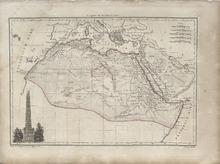
Description: Detailed single page copper engraved map of Northern Africa in Ancient times. Depicts the various ancient kingdoms as well as offering good detail of the deserts - some of which is entirely mythological. The map covers also the Southern European Continent from Iberian Peninsula to Greece, Middle East and Arabian Peninsula. The map is adorned with a decorative title cartouche embellished with an Egyptian obelisk. Sites appearing on the map include: Tamusiga, Mysocora, Sala (Chellah-destroyed by an earthquake in the 18th Century), Banasa (Iulia Valentia Banasa-destroyed in 285 AD), Volubilis (Destroyed in the 11th Century), Tingis (Tangiers), and Parietina, Morocco, Olisipo (Lisbon), Portugal, Carthago Nova (Cartagena), Dianium, and Tarraco (Tarragona), Spain, Massilia (Marseille), France, Caratis, Genua (Genoa), Roma (Rome), and Syracusae (Syracuse), Italy, Athenae (Athens), Greece, Siga, Mina, Medianum, Cartenna (Mostaganem), Caesarea, Vescotbra, Saldae (Destroyed 429 AD), Tabudis, Cirta (Constantine), and Hippo Reglus (Annaba), Algeria, Cathago (Carthage), and Tacape (Gabes), Tunisia, Sabrata (Sabratha), Cydamus (Ghadames), Matalgae, Aea, Leptis Magna, Gerisa, Cyllaba, Garama (Germa), Muchtasii, Cyrene, Darais, Mazala, Augila (Awjila), and Philenor Arae, Libya, Tucabath (Timbuktu), Mali, Byzantium (Istanbul), Sinope (Sinop), Antiocha (Antioch), and Tarsus, Turkey, Babylon, Iraq, Salamis, Cyprus, Palmyra and Damascus, Syria, Persepolis, Iran, Omanum, Oman, Iabris, Alata, Asca, Casandi, Nagrana, Aeli, Chaalla, Sacacia, Macoraba (Mecca), Chariatha, Maaddeni, Iambe, Iatrippa, Leuce Come, Thema, Raunati, Phaenicium Oppidum, Madian (Midian), Thumata, and Gerra (Gerrha), Saudi Arabia, Macala, Mariaba, Sabat, and Muza, Yemen, Aetana, and Petra, Jordan, Aerosolyma (Jerusalem), Israel, Alexandria, Petusium, Ammon, Maraotis, Memphis, Oasis Magna (Kharga), Antinoa, Ptolomais, Coptos (Qift), Theba (Thebes), Berenice, Premis Parva, Cambysis Aeraruim, and Arbos, Egypt, Satachtha, Napata, Candace, Ptolomais, Meroe (Merowe), Tolen, and Auxuma, Sudan, Adulis, Eritrea, Tyrus (Tyre), Lebanon, and the unsure sites of Talubath, Saluce, Nigira Metrop., Ta Gana, Taermunda, Boin, Neglagemela, Thapsagus, Disecra, Tabidium, Thube, Berenice, Saba, Niloptolemaeum, Zingis Extrema, Rapta, and Aesar. Source publication: Atlas Complet Du Precis De la Geographie Universelle De M. Malte Brun dressee par M. Lapie Capitaine Ingenieur Geographie Pierre M. Lapie (1779-1850) and his son Alexandre Emile Lapie (1809-1850) were French cartographers and engravers active in the early part of the 19th Century. The Lapies were commissioned officers in the French army holding the ranks of Colonel and Caipitan, respectively. Alexander enjoyed the title of "First Geographer to the King", and this title appears on several of his atlases. Both father and son were exceptional engraversand fastidious cartographers. Working separately and jointly they published four important atlases, an 1811 Atlas of the French Empire (Alexander), the 1812 Atlas Classique et Universel (Pierre), the Atlas Universel de Geographie Ancienne et Modern (joint issue), and the 1848 Atlas Militaire (Alexander). They also issued many smaller maps and independent issues. All of these are products of exceptional beauty and detail. Conrad Malte-Brun (1755-1826) was an important late 18th and early 19th Century Danish/French cartographer and revolutionary. Conrad was born in Thisted, Denmark. His parents encouraged him to a career in the Church, but he instead enrolled in the University of Copenhagen. In the liberal hall of academia Conrad became an ardent supporter of the French Revolution and the ideals of a free press. Despite the harsh censorship laws of crown prince Frederick VI, Malte-Brun published numerous pamphlets criticizing the Danish government. He was finally charged with defying censorship laws in 1799 and forced to flee to Sweden and ultimately France. Along with colleague Edme Mentelle, Malte-Brun published his first cartographic work, the Geographie mathematique, physique et politique de toutes les parties du monde (6 volumes published between 1803 and 1807). Conrad went on to found Les Annales des Voyages (in 1807) and Les Annales des Voyages, de la Geographie et de l'Histoire (in 1819). He also founded the Paris Societe de Geographie. In time, Conrad became known as one of the finest French cartographers of his time.
Member of: Antiquarian Maps Collection (1603-1863)
Resource Type: cartographic
Imperium Persicum tempore Cyri Magni (1739)
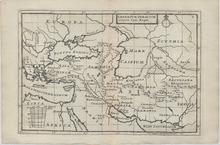
Description: Detailed copper engraved historic map showing the extension of the Persian Empire under Cyrus the Great. The map depicts modern-day Turkey, Cyprus, Greece, Crimean Peninsula, Ukraine, Syria, Lebanon, Israel, Armenia, Egypt, Arabian Peninsula, Iran, Iraq, and Northwestern India. The map is filled with a lot of geographical details concerning place names in Latin, Rivers, Lakes, Mountains, and Islands. The title is inside a simple cartouche. Citeis, Regions, Rivers, and Islands shown are: Europa (Europe), Tanais F. (Don River, Russia), Palus Maeotis (Sea of Azov or Maeotian Marshes/Maeotian Lake, Ukraine/Russia), Scythia, Ister F. (Danube River, Europe), Rha F. (Volga River, Russia), Illiricum (Roman Province of Modern-Day Albania, Croatia, Bosnia and Herzegovina, Montenegro and Serbia), Thracia (Roman Province of Modern-Day Bulgaria, Greece, and Turkey), Macedonia, Graecia (Greece), Epirus (Modern-Day parts of Albania and Greece), Asia Minor (Turkey), Phrygia (Turkey) Aegeum Mare (Aegean Sea), Caystrus F., Cuma (Cyme), Larissa (Ancient city destroyed in 279 BC), Sardes (Sart), Paetolus F., Caria, Lycia (Modern-Day parts of Antalya and Muğla), Pamphylia (Modern-Day Antalya), Cilicia, Piteria (Pteria ancient capital of the Assyrians destroyed in 547 BC), Paphalagonia, Cappadocia (Nevşehir), Halis F. (Kızılırmak River), Caucasus M. (Caucasus Mountains), Colchis, Phasis F. (Rioni River), Albania (Part of Modern-Day Azerbaijan and Dagestan), Armenia, Creta (Crete), Mare Mediterraneum (Mediterranean Sea), Libya, Barce (Marj), Cyrene (Ancient City destroyed by an Earthquake in 365 AD), Aegyptus (Egypt), Nilus F. (Nile River), Africa, Cyprus, Syria, Phoenice, Sinus Arabicus (Red Sea), Taurus M. (Taurus Mountains), Tigris F. (Tigris River), Euphrates F. (Euphrates River), Assyria (Northern Iraq, Northeast Syria, and Southeastern Turkey), Ninus (Nineveh), Mesopotamia (Iraq, Kuwait, Northeastern Syria, Southeastern Turkey, and Southwestern Iran), Babylon (Hillah), Babylonia (Iraq), Chaldaea, Arabia, Araxes F. (Aras River), Cadusci, Media (Northwestern Iran), Ecbatana (Hamedan), Susa (Shush), Susiana (Elam in West and Southwest Iran), Sinus Persicus (Persian Gulf), Persia (Iran), Persepolis, Cissii, Hyrcania (Parts of Modern-Day Northern Iran and Turkmenistan), Parthia (Northeastern Iran), Asia, Mardi, Carmania Deserta, Carmania (Kerman Province, Iran), Mare Erythraeum (Erythraean Sea), Gedrosia (Balochistan), Indus F. (Indus River), India, Arachosia (Modern-Day Southern Afghanistan and Pakistan), Aria (Northwest Afghanistan), Drangiana (Modern-Day Iran, Afghanistan, and Pakistan), Parapamisus, Bactriana (Northern Afghanistan), Mare Caspium (Caspian Sea), Caspii, Iaxartes F. (Syr Darya River), Sacae, Sogdiana (Tajikistan and Uzbekistan), Margiana (Afghanistan and Turkmenistan), and Oxus F. (Amu Darya River) The source publication is: Geographia antique, Latinorum et Graecorum, tabulis XXXII novis & accuratis expressa, translated: Thirty-two new and accurate maps of the geography of the ancients, as contained in the Greek and Latin Classics. It was printed and sold in 1739 in London by Thomas Bowles. Herman Moll was a Dutchman bookseller, geographer and engraver. Around 1678 he moved to London where for a while he continued as an engraver. Later, he started his own businesses a map publisher and by the turn of the century had become the most prominent map publisher in the country. He published atlases and loose maps of all parts of the world many of which were highly decorative. In 1724 he published his 'New Description of England and Wales', an atlas of the English and Welsh Counties. He had many interesting friends including Daniel Defoe, Jonathan Swift (for whom he provided maps for Robinson Crusoe and Gulliver's Travels), explorers William Damier and Woodes Rogers, and the scientist Robert Hooke.
Member of: Antiquarian Maps Collection (1603-1863)
Resource Type: cartographic
They shall not perish
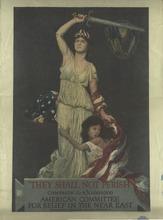
Description: The poster depicts a young ethnic girl, symbolizing the Near East, clinging to Miss Columbia with sword, symbolizing America. Both are wrapped in an American flag.,Girl, symbolizing Near East, clinging to woman with sword and U.S. flag, symbolizing America.
Resource Type: Still Image
The Turkish Empire
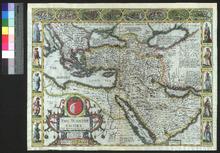
Description: On verso: Text: The Description of the Turkish Empire
Member of: Venable Maps
Resource Type: cartographic
Turcici Imperii Descriptio
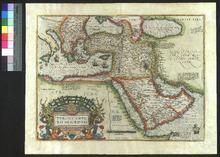
Description: Appeared in Ortelius' Theatrum Orbis Terrarum (1570). The cartouche was altered in 1579. Dutch editions of Theatrum Orbis Terrarum with the original plate were printed in 1571 and 1573.,On verso: Text: Turckyen
Member of: Venable Maps
Resource Type: cartographic
New Map of Persia
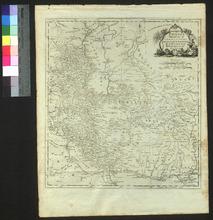
Description: Appeared in Millar's New and Universal System of Geography (1782-1785),On verso: Blank
Member of: Venable Maps
Resource Type: cartographic
Turcicum Imperium
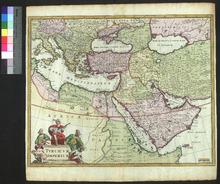
Description: Second state of the map; the earlier state included L'Huilier's credit in the lower right border.,On verso: Blank
Member of: Venable Maps
Resource Type: cartographic
De Reys-togten van Abraham
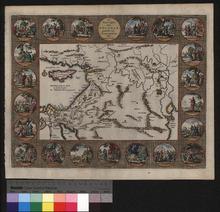
Description: On verso: Handwritten date and place
Member of: Venable Maps
Resource Type: cartographic
